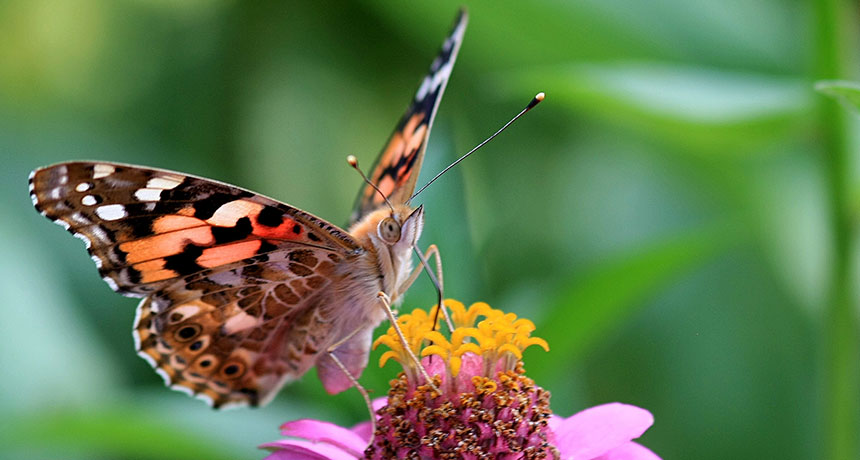Life Cycle Miracle (Butterfly Larvae)
Grades: K-5
Time: The butterfly life cycle takes 3-4 weeks to complete.

ORDER HERE
Watch Painted Lady caterpillars grow, form chrysalides, and hatch into butterflies. Learn about the anatomy, life cycle, and the role of a butterfly in its environment. Compare the similarities and differences between a butterfly and a moth.
Order Deadline: Thursday, March 5, 2026
Pick Up: Thursday, March 26, 2026
Teacher Provides:
- Continuous care and supervision of larvae, chrysalides and butterflies until released outside
- Butterfly enclosure (purchase optional) and other supplies such as butterfly food, etc.
Program Includes:
- Butterfly larva cups (3 to 5 larvae) with larvae food are available for purchase at $23.00
- Butterfly enclosures are available to purchase
- Teacher guide and student booklet
Teacher Resources
Facts About Painted Lady Butterflies
Answers to Kids Questions About Butterflies
Butterflies in the United States
Videos:
Painted Lady Butterfly Emerging From Chrysalis
Physics of Butterfly Flight
Video Series Part I
Video Series Part II
Video Series Part III
Kansas State Standards:
Kindergarten
- K-SL.K.3 Ask and answer questions in order to seek help, get information, or clarify something that is not understood.
- K-LS1-1. Use observations to describe patterns of what plants and animals (including humans) need to survive.
- K-W.K.2 Use a combination of drawing, dictating, and writing to compose informative/explanatory texts in which they name what they are writing about and supply some information about the topic.
- K-SL.K.5 Add drawings or other visual displays to descriptions as desired to provide additional detail.
- K-LS1.C: Organization for Matter and Energy Flow in Organisms : All animals need food in order to live and grow. They obtain their food from plants or from other animals. Plants need water and light to live and grow. (K-LS1-1)
- K-ESS3.A: Natural Resources : Living things need water, air, and resources from the land, and they live in places that have the things they need. Humans use natural resources for everything they do. (K-ESS3-1)
First Grade
- 1-W.1.8 With guidance and support from adults, recall information from experiences or gather information from provided sources to answer a question.
- 1-LS1-1. Use materials to design a solution to a human problem by mimicking how plants and/or animals use their external parts to help them survive, grow, and meet their needs.
- 1-LS1-2. Read texts and use media to determine patterns in behavior of parents and offspring that help offspring survive.
- 1-LS1.A: Structure and Function: All organisms have external parts. Different animals use their body parts in different ways to see, hear, grasp objects, protect themselves, move from place to place, and seek, find, and take in food, water, and air. Plants also have different parts (roots, stems, leaves, flowers, fruits) that help them survive and grow. (1-LS1-1)
- 1-LS1.B: Growth and Development of Organisms : Adult plants and animals can have young. In many kinds of animals, parents, and the offspring themselves engage in behaviors that help the offspring to survive. (1-LS1-2)
- 1-LS3.B: Variation of Traits : Individuals of the same kind of plant or animal are recognizable as similar but can also vary in many ways. (1-LS3-1)
Second Grade
- 2-W.2.8 Recall information from experiences or gather information from provided sources to answer a question.
- 2-LS2-2. Develop a simple model that mimics the function of an animal in dispersing seeds or pollinating plants.
- 2-LS4-1. Make observations of plants and animals to compare the diversity of life in different habitats.
- 2-SL.2.2 Recount or describe key ideas or details from a text read aloud or information presented orally or through other media.
Third Grade
- 3-SL.3.3 Ask and answer questions about information from a speaker, offering appropriate elaboration and detail.
- 3-MP.2 Reason abstractly and quantitatively.
- 3-LS1-1. Develop models to describe that organisms have unique and diverse life cycles but all have in common birth, growth, reproduction, and death.
- 3-LS3-2. Use evidence to support the explanation that traits can be influenced by the environment.
- 3-LS4-2. Use evidence to construct an explanation for how the variations in characteristics among individuals of the same species may provide advantages in surviving, finding mates, and reproducing.
- 3-LS1.B: Growth and Development of Organisms : Reproduction is essential to the continued existence of every kind of organism. Plants and animals have unique and diverse life cycles. (3-LS1-1)
- 3-LS4.C: Adaptation : For any particular environment, some kinds of organisms survive well, some survive less well, and some cannot survive at all. (3-LS4-3)
Fourth Grade
- 4-W.4.9 Draw evidence from literary or informational texts to support analysis, reflection, and research.
- 4-MP.2 Reason abstractly and quantitatively
- 4-LS1-1. Construct an argument that plants and animals have internal and external structures that function to support survival, growth, behavior, and reproduction.
- 4-LS1-2. Use a model to describe that animals receive different types of information through their senses, process the information in their brain, and respond to the information in different ways.
- 4-LS1.A: Structure and Function : Plants and animals have both internal and external structures that serve various functions in growth, survival, behavior, and reproduction. (4-LS1-1)
- 4-LS1.D: Information Processing : Different sense receptors are specialized for particular kinds of information, which may be then processed by the animal’s brain. Animals are able to use their perceptions and memories to guide their actions. (4-LS1-2)